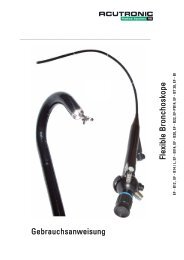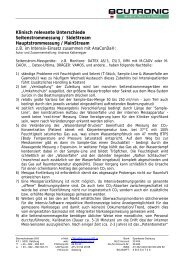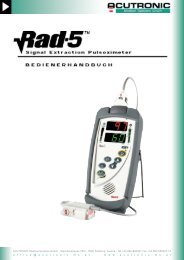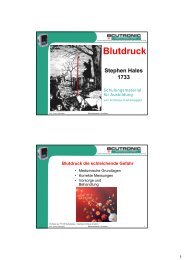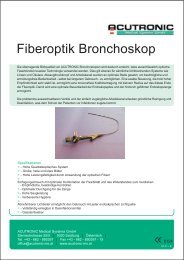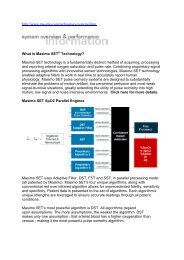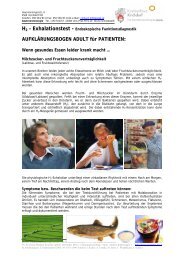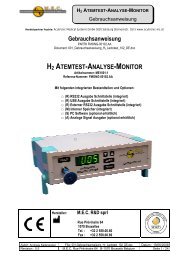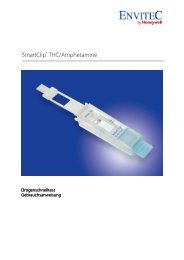Summary Carbon Monoxide Lurking within: The Danger of ...
Summary Carbon Monoxide Lurking within: The Danger of ...
Summary Carbon Monoxide Lurking within: The Danger of ...
Create successful ePaper yourself
Turn your PDF publications into a flip-book with our unique Google optimized e-Paper software.
masimo corporation 40 parker irvine ca 92618 www.masimo.com<br />
Demystifying Carboxyhemoglobinemia - ED<br />
Detection<br />
Table 2: COHb Levels in Persons 3 - 74 Years <strong>of</strong> Age 20<br />
Smoking Status<br />
Percent COHb<br />
(mean + SD)<br />
Percent COHb<br />
(98th percentile)<br />
Nonsmokers 0.83 + 0.67 < 2.50<br />
Current smokers 4.30 + 2.55 < 10.00<br />
All statuses combined 1.94 + 2.24 < 9.00<br />
One thing that is certain about COHb levels is that smokers present with higher levels than do<br />
non-smokers. As can be seen in Table 2, 20 the COHb level in non-smokers is approximately<br />
one to two percent. In patients who smoke, a baseline level <strong>of</strong> nearly five percent is considered<br />
normal, although it can be as high as 13 percent. Although COHb concentrations between 11<br />
percent and 30 percent can produce symptoms, it is important to consider the patient’s smoking<br />
status.<br />
CO poisoning is known as the great imitator for its ability to present with equivocal signs and<br />
symptoms, many <strong>of</strong> which closely resemble other diseases. In particular, patients may be<br />
misdiagnosed with viral illness, acute myocardial infarction, and migraine. It is estimated that CO<br />
poisoning misdiagnosis may occur in up to 30-50 percent <strong>of</strong> CO-exposed patients presenting to<br />
emergency departments. 21-23 As described below, failing to assess COHb levels early may return<br />
vulnerable patients and their families to potentially lethal environments.<br />
Missing the Signs<br />
A 67-year-old man sought medical help after three days <strong>of</strong> light-headedness,<br />
vertigo, stabbing chest pain, cough, chills and headache. His wife had experienced<br />
similar ailments over the past week. He was admitted, evaluated and discharged<br />
with a diagnosis <strong>of</strong> viral syndrome. Ten days later he returned to the ER with vertigo,<br />
palpitations and nausea but was sent home for outpatient follow-up. Four days<br />
later he again returned to the ER with diarrhea and severe chest pain, collapsing<br />
to the fl oor. He was admitted to the Coronary Care Unit with acute myocardial<br />
infarction. Among the results <strong>of</strong> a routine arterial blood gas analysis, it was found<br />
that his COHb levels were 15.6%. A COHb level then obtained on his wife was<br />
18.1%. A rusted furnace was found to be the source. 15<br />
A 69-year-old man came to the ER after days <strong>of</strong> confusion, nausea, vomiting,<br />
intermittent syncope, hallucinations and shortness <strong>of</strong> breath. An arterial blood<br />
gas measurement found an oxygen saturation <strong>of</strong> 89%. He was admitted to the<br />
coronary care unit with a diagnosis <strong>of</strong> acute myocardial infarction. <strong>The</strong> next day<br />
a COHb level was measured and normal. While the patient was hospitalized he<br />
invited his sister and daughter-in-law to stay in his home. <strong>The</strong>y both arrived at the<br />
ER the next morning with headaches, vomiting, and vertigo. <strong>The</strong>ir COHb levels on<br />
initial observation were 28% and 32%. <strong>The</strong> man’s gas water heater was faulty. 15<br />
A 47-year-old male urologist and his wife attended a medical conference in Jackson,<br />
Wyoming. Both reported to a local emergency department with symptoms<br />
including headache, malaise, and metabolic acidosis. <strong>The</strong> husband and wife were<br />
sent back to the conference resort hotel with a diagnosis <strong>of</strong> gastroenteritis. <strong>The</strong><br />
following day, they were both found unresponsive in their hotel. He died 3 hours<br />
later, and his wife has severe long-term neurocognitive sequelae. <strong>The</strong> cause <strong>of</strong><br />
death and long-term morbidity was carbon monoxide poisoning due to a faulty<br />
boiler. A $17,000,000 verdict was awarded to the affl icted family against the<br />
resort hotel owners.



